fuel cap TOYOTA C-HR 2018 1.G Owners Manual
[x] Cancel search | Manufacturer: TOYOTA, Model Year: 2018, Model line: C-HR, Model: TOYOTA C-HR 2018 1.GPages: 516, PDF Size: 9.32 MB
Page 3 of 516
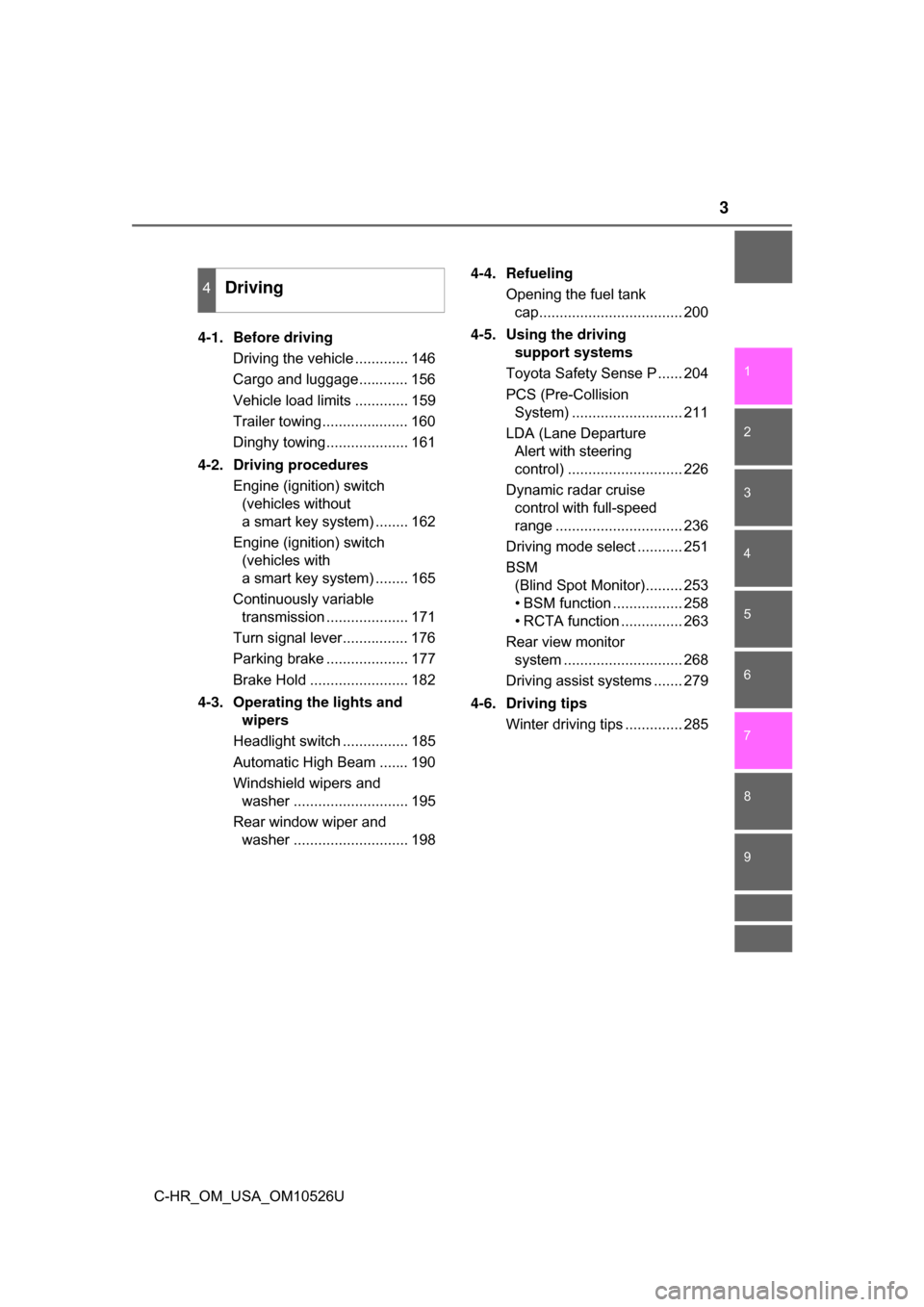
3
1
8 7 5 4
3
2
9
C-HR_OM_USA_OM10526U
6
4-1. Before drivingDriving the vehicle ............. 146
Cargo and luggage............ 156
Vehicle load limits ............. 159
Trailer towing..................... 160
Dinghy towing.................... 161
4-2. Driving procedures Engine (ignition) switch (vehicles without
a smart key system) ........ 162
Engine (ignition) switch (vehicles with
a smart key system) ........ 165
Continuously variable transmission .................... 171
Turn signal lever................ 176
Parking brake .................... 177
Brake Hold ........................ 182
4-3. Operating the lights and wipers
Headlight switch ................ 185
Automatic High Beam ....... 190
Windshield wipers and washer ............................ 195
Rear window wiper and washer ............................ 198 4-4. Refueling
Opening the fuel tank cap................................... 200
4-5. Using the driving support systems
Toyota Safety Sense P ...... 204
PCS (Pre-Collision System) ........................... 211
LDA (Lane Departure Alert with steering
control) ............................ 226
Dynamic radar cruise control with full-speed
range ............................... 236
Driving mode select ........... 251
BSM (Blind Spot Monitor)......... 253
• BSM function ................. 258
• RCTA function ............... 263
Rear view monitor system ............................. 268
Driving assist systems ....... 279
4-6. Driving tips Winter driving tips .............. 285
4Driving
Page 13 of 516

13Pictorial index
C-HR_OM_USA_OM10526UWindshield wipers . . . . . . . . . . . . . . . . . . . . . . . . . . . . . . . . . P. 195
Precautions for winter . . . . . . . . . . . . . . . . . . . . . . . . . . . . . . . P. 285
Fuel filler door . . . . . . . . . . . . . . . . . . . . . . . . . . . . . . . . . . . . P. 200
Refueling method . . . . . . . . . . . . . . . . . . . . . . . . . . . . . . . . . . . P. 200
Fuel type/fuel tank capacity . . . . . . . . . . . . . . . . . . . . . . . . . . . P. 452
Tires . . . . . . . . . . . . . . . . . . . . . . . . . . . . . . . . . . . . . . . . . . . . P. 353
Tire size/inflation pressure . . . . . . . . . . . . . . . . . . . . . . . . . P. 456
Winter tires/tire chains . . . . . . . . . . . . . . . . . . . . . . . . . . . . P. 285
Checking/rotation/tire pressure warning system . . . . . . . . . P. 353
Coping with flat tires . . . . . . . . . . . . . . . . . . . . . . . . . . . . . . P. 423
Hood . . . . . . . . . . . . . . . . . . . . . . . . . . . . . . . . . . . . . . . . . . . . P. 338
Opening . . . . . . . . . . . . . . . . . . . . . . . . . . . . . . . . . . . . . . . . . . P. 338
Engine oil . . . . . . . . . . . . . . . . . . . . . . . . . . . . . . . . . . . . . . . . . P. 452
Coping with overheating . . . . . . . . . . . . . . . . . . . . . . . . . . . . . P. 443
Camera . . . . . . . . . . . . . . . . . . . . . . . . . . . . . . . . . . . . . . . . . . P. 268
Headlights/parking lights/
daytime running lights/
side marker lights/turn signal lights . . . . . . . . . . . . . . P. 176, 185
Side turn signal lights . . . . . . . . . . . . . . . . . . . . . . . . . . . . . . P. 176
Stop lights/tail lights/side marker lights/
turn signal lights . . . . . . . . . . . . . . . . . . . . . . . . . . . . . . P. 176, 185
Tail lights (LED type)
*. . . . . . . . . . . . . . . . . . . . . . . . . . . . . . P. 185
Back-up lights
Shifting the shift lever to R . . . . . . . . . . . . . . . . . . . . . . . . . . . . P. 171
License plate lights . . . . . . . . . . . . . . . . . . . . . . . . . . . . . . . . P. 185
Light bulbs of the exterior lights for driving
(Replacing method: P. 381, Watts: P. 457)
*: If equipped
Page 145 of 516
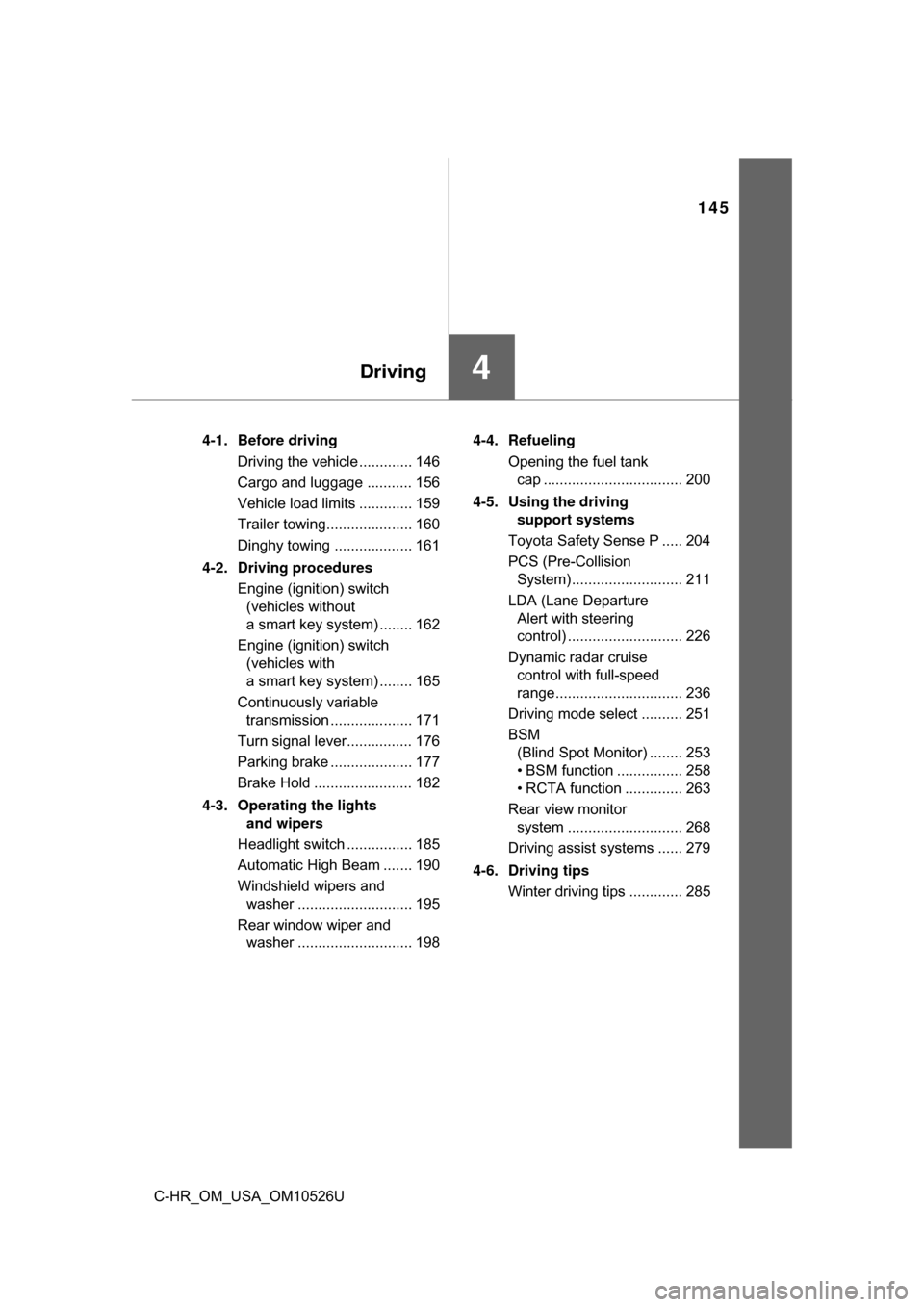
145
4Driving
C-HR_OM_USA_OM10526U4-1. Before driving
Driving the vehicle ............. 146
Cargo and luggage ........... 156
Vehicle load limits ............. 159
Trailer towing..................... 160
Dinghy towing ................... 161
4-2. Driving procedures Engine (ignition) switch (vehicles without
a smart key system) ........ 162
Engine (ignition) switch (vehicles with
a smart key system) ........ 165
Continuously variable transmission .................... 171
Turn signal lever................ 176
Parking brake .................... 177
Brake Hold ........................ 182
4-3. Operating the lights and wipers
Headlight switch ................ 185
Automatic High Beam ....... 190
Windshield wipers and washer ............................ 195
Rear window wiper and washer ............................ 198 4-4. Refueling
Opening the fuel tank cap .................................. 200
4-5. Using the driving support systems
Toyota Safety Sense P ..... 204
PCS (Pre-Collision System)........................... 211
LDA (Lane Departure Alert with steering
control) ............................ 226
Dynamic radar cruise control with full-speed
range............................... 236
Driving mode select .......... 251
BSM (Blind Spot Monitor) ........ 253
• BSM function ................ 258
• RCTA function .............. 263
Rear view monitor system ............................ 268
Driving assist systems ...... 279
4-6. Driving tips Winter driving tips ............. 285
Page 200 of 516

2004-4. Refueling
C-HR_OM_USA_OM10526U
Opening the fuel tank cap
●Vehicles without a smart key system
Turn the engine switch to the “LOC K” position and ensure that all
the doors and windows are closed.
● Vehicles with a smart key system
Turn the engine switch off and ens ure that all the doors and win-
dows are closed.
● Confirm the type of fuel.
■Fuel types
→P. 458
■ Fuel tank opening for unleaded gasoline
To help prevent incorrect fueling, your vehicle has a fuel tank opening that
only accommodates the special nozzle on unleaded fuel pumps.
Perform the following steps to open the fuel tank cap:
Before refueling the vehicle
Page 201 of 516
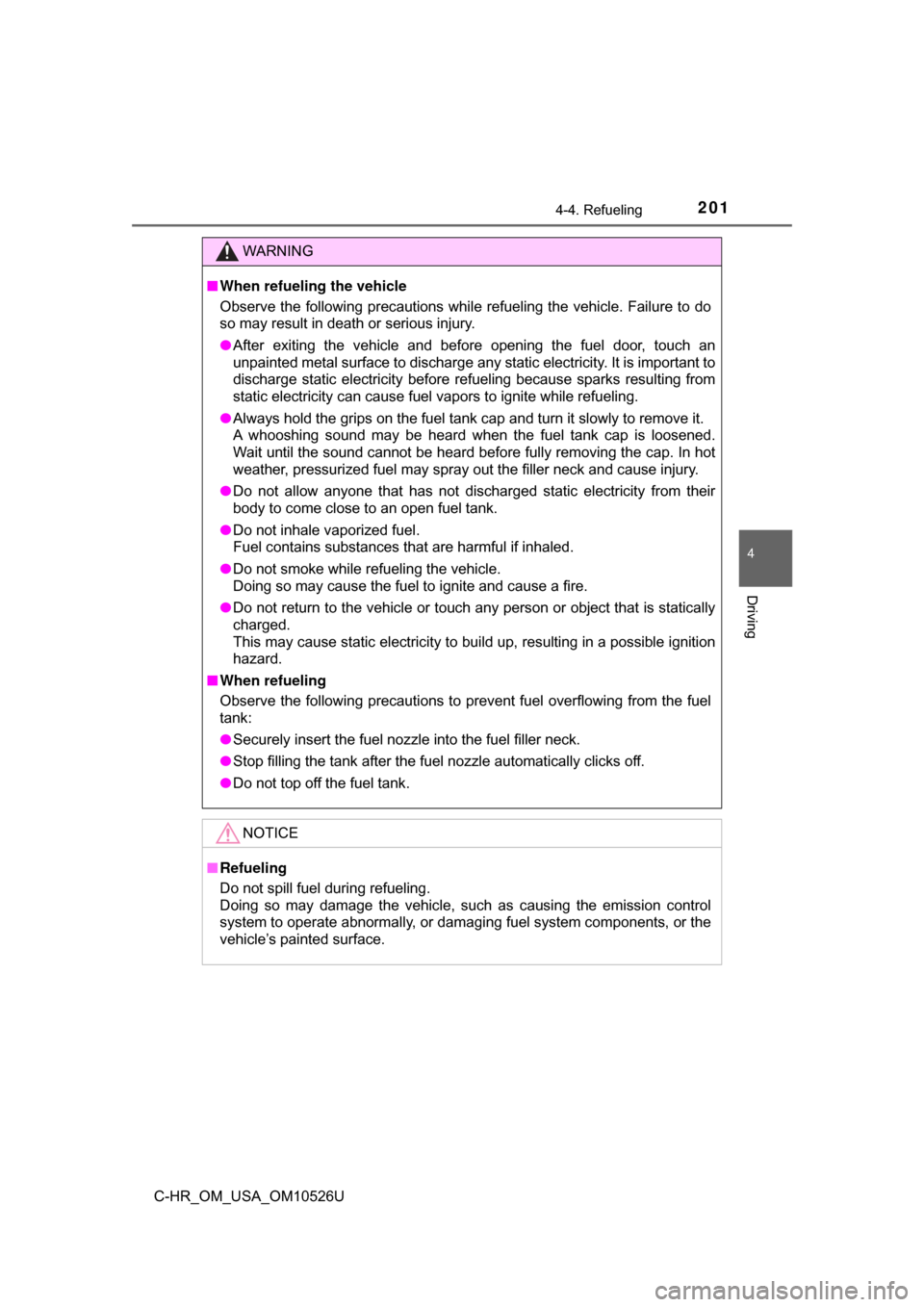
2014-4. Refueling
4
Driving
C-HR_OM_USA_OM10526U
WARNING
■When refueling the vehicle
Observe the following precautions while refueling the vehicle. Failure to do
so may result in death or serious injury.
● After exiting the vehicle and before opening the fuel door, touch an
unpainted metal surface to discharge any static electricity. It is important to
discharge static electricity before refueling because sparks resulting from
static electricity can cause fuel vapors to ignite while refueling.
● Always hold the grips on the fuel tank cap and turn it slowly to remove it.
A whooshing sound may be heard when the fuel tank cap is loosened.
Wait until the sound cannot be heard before fully removing the cap. In hot
weather, pressurized fuel may spray out the filler neck and cause injury.
● Do not allow anyone that has not discharged static electricity from their
body to come close to an open fuel tank.
● Do not inhale vaporized fuel.
Fuel contains substances that are harmful if inhaled.
● Do not smoke while refueling the vehicle.
Doing so may cause the fuel to ignite and cause a fire.
● Do not return to the vehicle or touch any person or object that is statically
charged.
This may cause static electricity to build up, resulting in a possible ignition
hazard.
■ When refueling
Observe the following precautions to prevent fuel overflowing from the fuel
tank:
● Securely insert the fuel nozzle into the fuel filler neck.
● Stop filling the tank after the fuel nozzle automatically clicks off.
● Do not top off the fuel tank.
NOTICE
■Refueling
Do not spill fuel during refueling.
Doing so may damage the vehicle, such as causing the emission control
system to operate abnormally, or damaging fuel system components, or the
vehicle’s painted surface.
Page 202 of 516
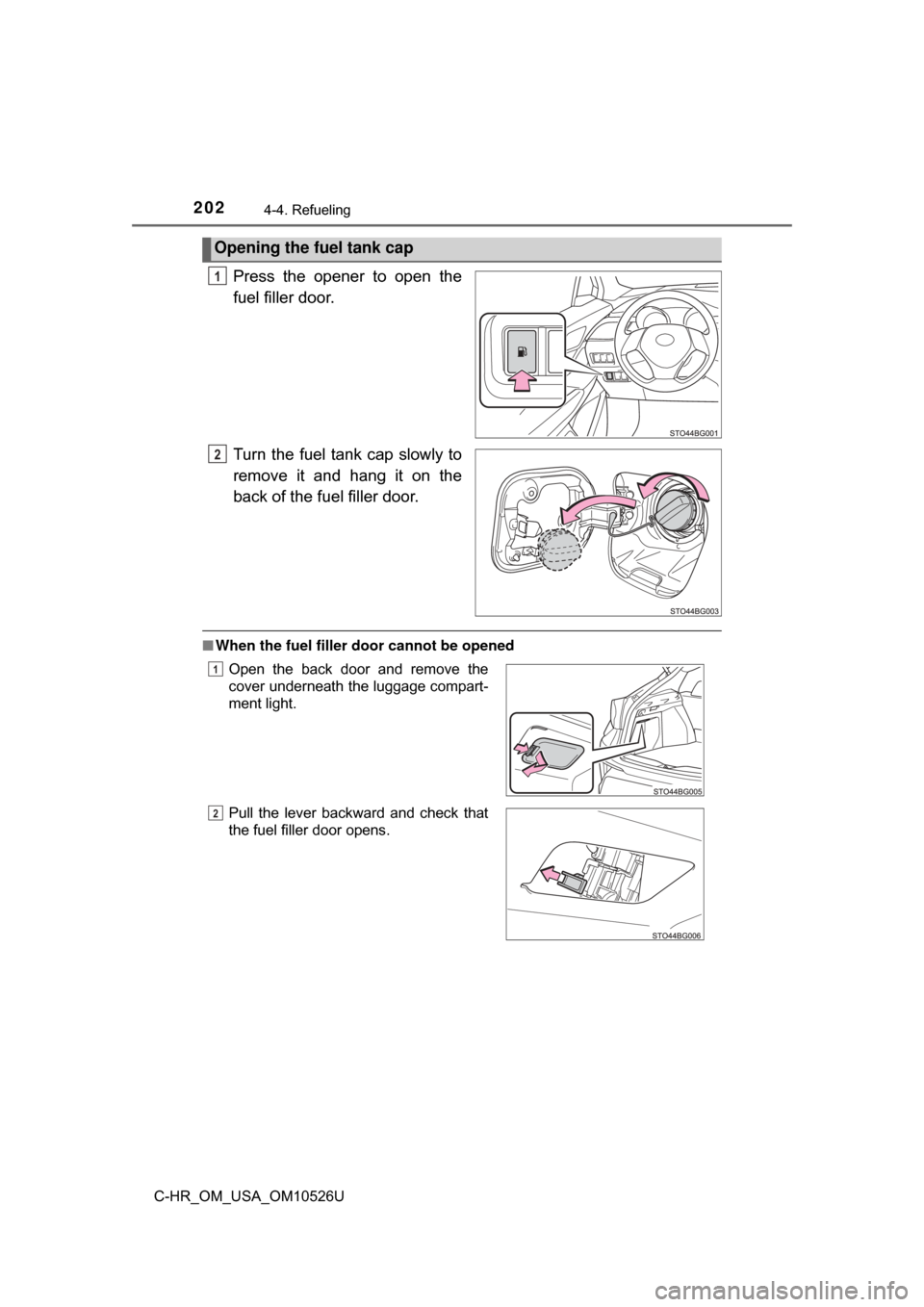
2024-4. Refueling
C-HR_OM_USA_OM10526U
Press the opener to open the
fuel filler door.
Turn the fuel tank cap slowly to
remove it and hang it on the
back of the fuel filler door.
■When the fuel filler door cannot be opened
Opening the fuel tank cap
1
2
Open the back door and remove the
cover underneath the luggage compart-
ment light.
Pull the lever backward and check that
the fuel filler door opens.1
2
Page 203 of 516
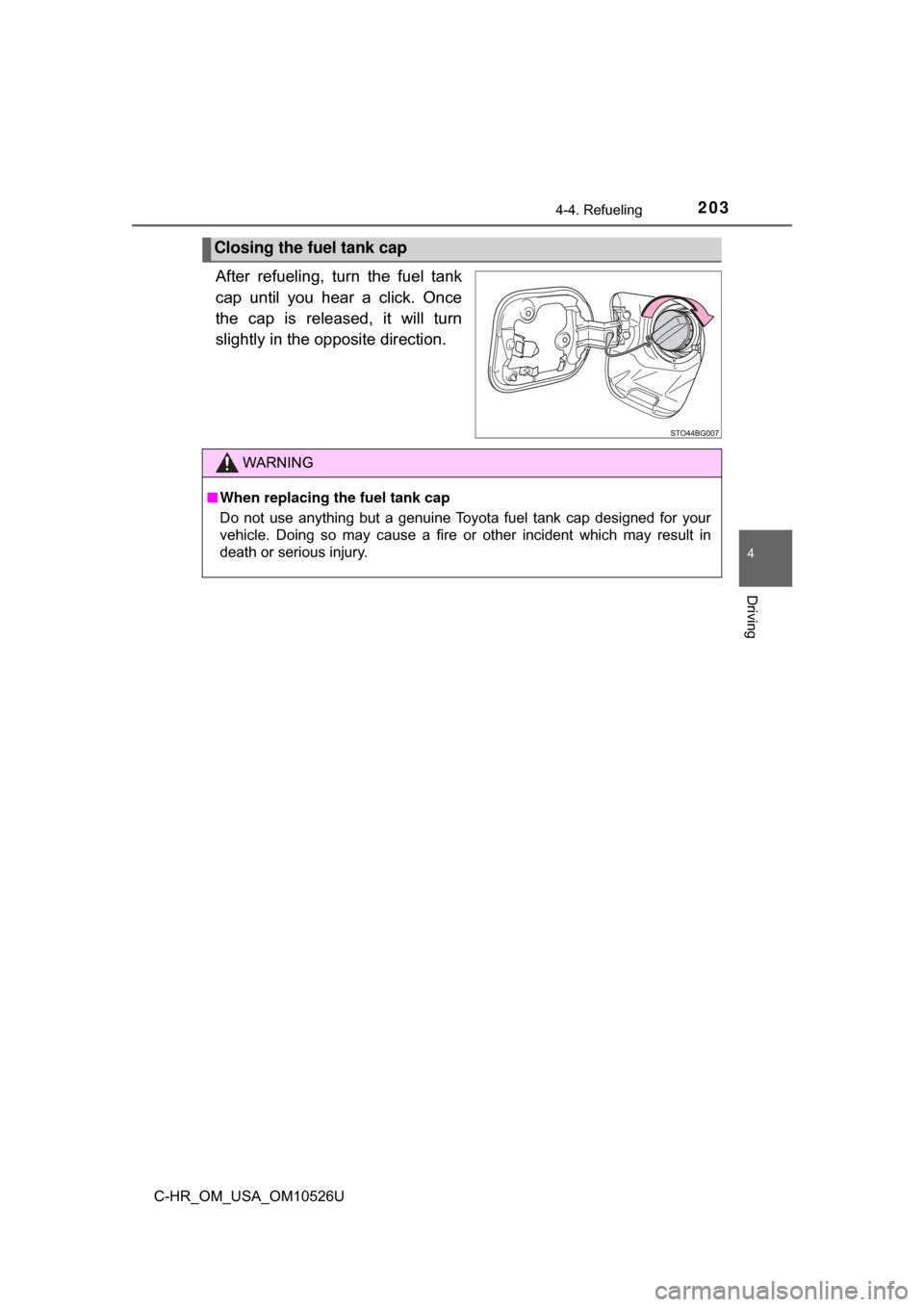
2034-4. Refueling
4
Driving
C-HR_OM_USA_OM10526U
After refueling, turn the fuel tank
cap until you hear a click. Once
the cap is released, it will turn
slightly in the opposite direction.
Closing the fuel tank cap
WARNING
■When replacing the fuel tank cap
Do not use anything but a genuine Toyota fuel tank cap designed for your
vehicle. Doing so may cause a fire or other incident which may result in
death or serious injury.
Page 295 of 516

2955-1. Using the air conditioning system and defogger
5
Interior features
C-HR_OM_USA_OM10526U
■Using automatic mode
Fan speed is adjusted automatically according to the temperature setting and
the ambient conditions.
Therefore, the fan may stop for a while until warm or cool air is ready to flow
immediately after is pressed.
■ Fogging up of the windows
●The windows will easily fog up when the humidity in the vehicle is high.
Turning on will dehumidify the air from the outlets and defog the
windshield effectively.
● If you turn off, the windows may fog up more easily.
● The windows may fog up if the recirculated air mode is used.
■ Outside/recirculated air mode
●When driving on dusty roads, in tunnels, or in heavy traffic set the outside/
recirculated air mode button to the recirculated air mode. This is effective in
preventing outside air from entering the vehicle interior. During cooling oper-
ation, setting the recirculated air mode will also cool the vehicle interior
effectively.
● Outside/recirculated air mode may automatically switch depending on the
temperature setting or the inside temperature.
■ Operation of the air conditio ning system in Eco drive mode
● In Eco drive mode, the air conditioning system is controlled as follows to pri-
oritize fuel efficiency:
• Engine speed and compressor operation controlled to restrict heating/
cooling capacity
• Fan speed restricted when automatic mode is selected
● To improve air conditioning performance, perform the following operations:
• Adjust the fan speed
• Adjust the temperature setting
• Turn off Eco drive mode
● Even when the drive mode is set to Eco drive mode, the air conditioning eco
mode can be turned off by pressing .
Page 334 of 516
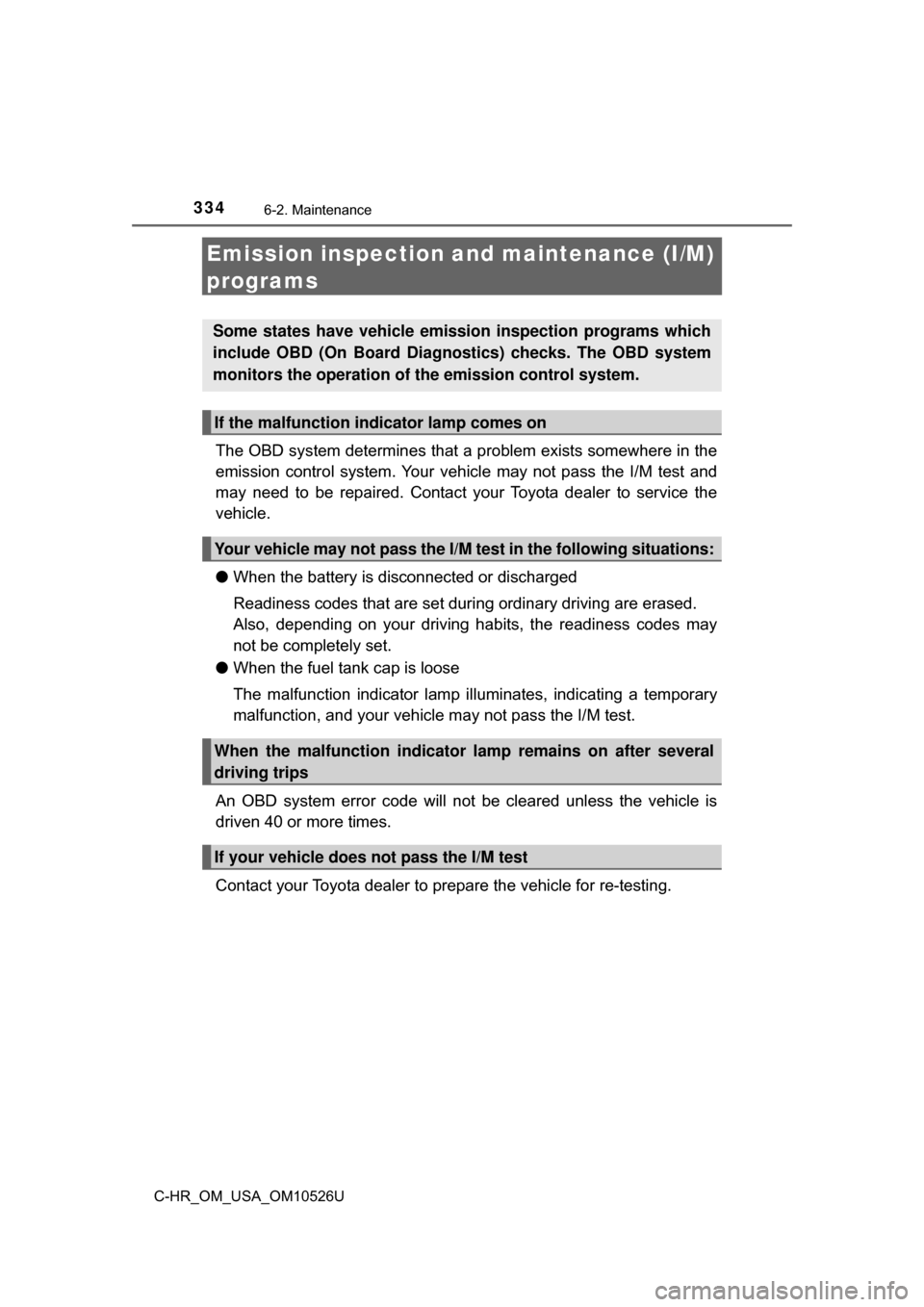
3346-2. Maintenance
C-HR_OM_USA_OM10526U
Emission inspection and maintenance (I/M)
programs
The OBD system determin es that a problem exists somewhere in the
emission control system. Your vehi cle may not pass the I/M test and
may need to be repaired. Contact your Toyota dealer to service the
vehicle.
● When the battery is disconnected or discharged
Readiness codes that are set duri ng ordinary driving are erased.
Also, depending on your driving habits, the readiness codes may
not be completely set.
● When the fuel tank cap is loose
The malfunction indicator lamp illu minates, indicating a temporary
malfunction, and your vehicle may not pass the I/M test.
An OBD system error code will not be cleared unless the vehicle is
driven 40 or more times.
Contact your Toyota dealer to prepare the vehicle for re-testing.
Some states have vehicle emission inspection programs which
include OBD (On Board Diagnos tics) checks. The OBD system
monitors the operation of the emission control system.
If the malfunction indicator lamp comes on
Your vehicle may not pass the I/M test in the following situations:
When the malfunction indicator lamp remains on after several
driving trips
If your vehicle does not pass the I/M test
Page 365 of 516
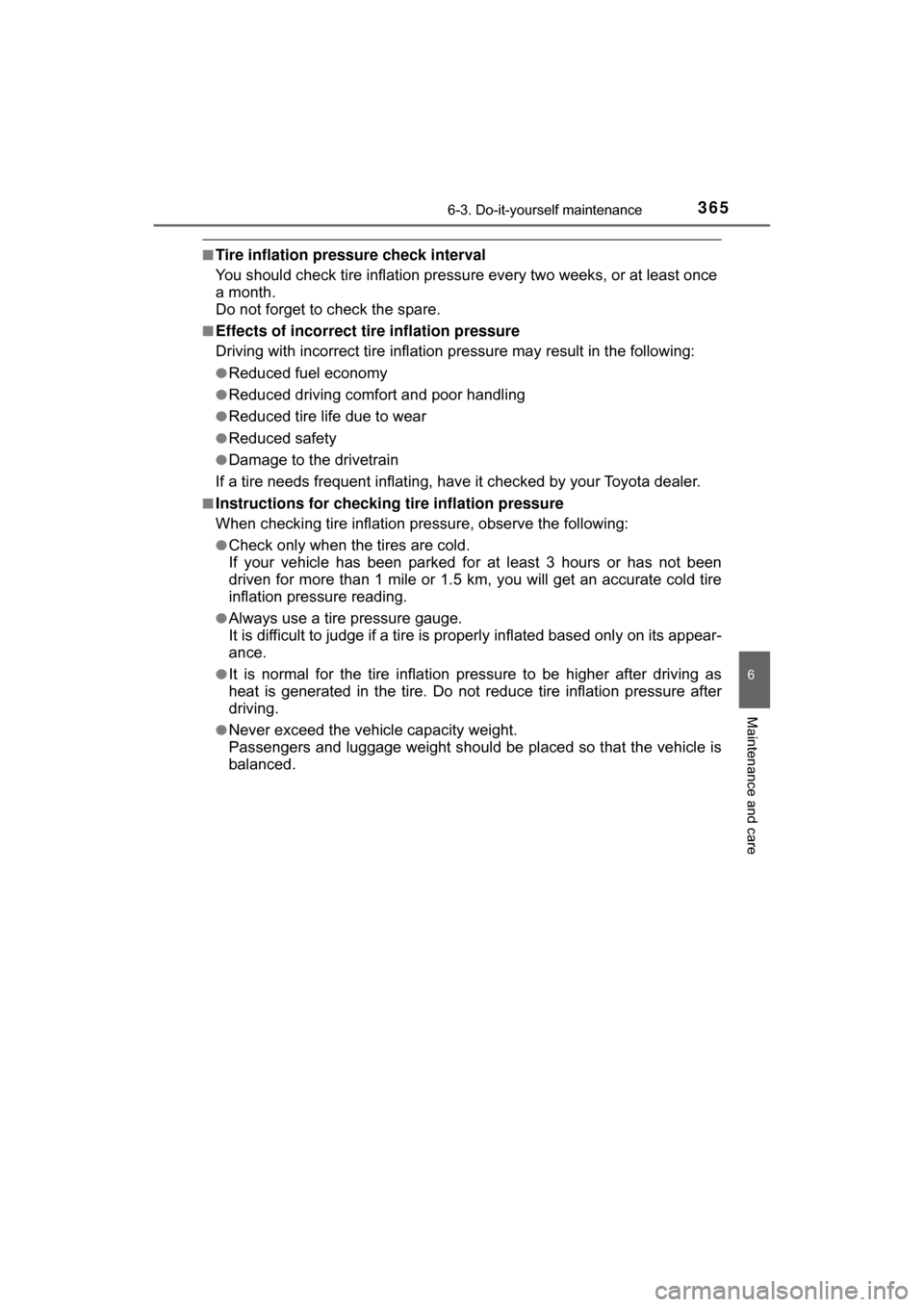
3656-3. Do-it-yourself maintenance
6
Maintenance and care
C-HR_OM_USA_OM10526U
■Tire inflation pressure check interval
You should check tire inflation pressure every two weeks, or at least once
a month.
Do not forget to check the spare.
■Effects of incorrect tire inflation pressure
Driving with incorrect tire inflation pressure may result in the following:
●Reduced fuel economy
●Reduced driving comfort and poor handling
●Reduced tire life due to wear
●Reduced safety
●Damage to the drivetrain
If a tire needs frequent inflating, have it checked by your Toyota dealer.
■Instructions for checking tire inflation pressure
When checking tire inflation pressure, observe the following:
●Check only when the tires are cold.
If your vehicle has been parked for at least 3 hours or has not been
driven for more than 1 mile or 1.5 km, you will get an accurate cold tire
inflation pressure reading.
●Always use a tire pressure gauge.
It is difficult to judge if a tire is properly inflated based only on its appear-
ance.
●It is normal for the tire inflation pressure to be higher after driving as
heat is generated in the tire. Do no t reduce tire inflation pressure after
driving.
●Never exceed the vehicle capacity weight.
Passengers and luggage weight should be placed so that the vehicle is
balanced.